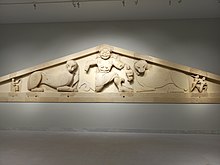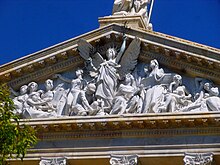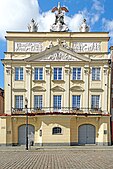Pedimental sculpture

Pedimental sculpture is a form of

In Romanesque architecture, and very often in Gothic architecture, the tympanum is usually semi-circular at the top, and the sculptural groups, usually with religious subjects, adapted to fit the new spaces. In the Renaissance triangular pediments returned, as gradually did sculptural groups within them, becoming very popular for important buildings in the 19th century.
History

Ancient Greek architecture
The pediment begins in
The "earliest pedimental composition to have survived," from the
Gorgons and gorgon heads were the most common early pedimental sculptures, as an architectural version of the
Greek temples with pediment sculptures usually had them at both ends of the temple, and tended to have contrasting scenes, one perhaps a peaceful scene with deities, and the other with a battle or dramatic scene from mythology.
Over the next decades refinements were made in the design and carving of pedimental sculpture, the small "Hydra pediment" in Athens (about 570 BCE), the "Bluebeard pediment from the 'old Athena temple' the
In the late or Hellenistic phase of Etruscan art, after about 300 BCE, Greek-style groups were introduced, but in terracotta rather than stone; some large fragments of these have survived.[11] The Romans also used terracotta,[12] but also stone for the grandest temples. An Amazonomachy in marble on the Temple of Apollo Sosianus in Rome, whose fragments were excavated in the 1930s, is thought to be a Greek work of the 5th century BCE, removed by the Romans from a temple there in the 1st century CE. Allusions to the recent Battle of Actium have been proposed.[13] The group on the final rebuilding of the Capitoline Temple of Jupiter Optimus Maximus is known from literary descriptions and depictions in other works of art, but none of it is known to survive.[14]
The Parthenon
The Parthenon's west pediment depicted the contest between Athena and Poseidon over Attica and the east pediment the birth of Athena.[15] Classical archeologists since Johann Joachim Winckelmann's Geschichte der Kunst des Alterthums (published 1764) have recognized Greek pediment sculpture, in particular the pediments of the Parthenon, as the standard of the highest-quality art in antiquity.[16] For Martin Schede, writing in 1923, the remains of limestone pediments, although "badly shattered indeed," represented "the highest artistic achievement of two generations of a most artistic people," the value of which was impossible to overestimate.[17] The travel writer Solomon Charles Kaines Smith specifically named the "Three Fates" of the east pediment the "highest surviving achievement of Greek sculpture,"[18] and for Wincklemann's contemporary Ennio Quirino Visconti the Parthenon pediments "met the criteria for the best artists of the best period."[19] The Parthenon compositions are considered to be the magnum opus of Classical pedimental decoration.[20]
Awareness of the Parthenon pediments, almost the only classical example to substantially survive in situ to the Renaissance, and eventually highly influential, increased only gradually in Western Europe. They were first drawn, not accurately, in 1436 by
The British Museum holds 17 figurative pedimental sculptures from the Parthenon, as part of the so-called Elgin Marbles, in their permanent collection.[22] The rest of the pedimental sculpture from the Parthenon is now on display in the Acropolis Museum at Athens.

Post-classical
Sculptures above lintels continued to be produced, indeed became more common, in post-classical architectural styles, but in recent times the medieval examples tend not to be called "pedimental sculptures", although it is technically correct to do so. "Tympanum reliefs" is a more common term, as these are now mostly in a relatively low relief, and less than life-size, as they are lower down the building, over doorways, and so closer to the observer than on classical temples. They are typically framed by round tops in
Renaissance and Baroque

The low triangular pediment was revived, initially mainly for the main facade of churches, in
Most buildings with pediments by Andrea Palladio followed the simpler formulae, but some of his villas around the Veneto feature large sprawling figures supporting the coat of arms, so that most of the tympanum is filled. Examples are the Villa Barbaro (completed c. 1558) and Villa Emo (by 1561). The small Tempietto Barbaro near the villa (c. 1583) has a composition in stucco with eight figures filling the space; like some other examples this seems to have been added after the rest of the building was finished, and the designer and sculptor are unknown.
Such compositions remained uncommon in
Heraldic sculptures
-
Borghese arms of Pope Paul IV, 1550s
-
Blenheim Palace, 1710s, with trophies of arms.
-
Działyński Palace, Poznań, Poland, 1773 - 1776
Neoclassicism

The arrival of Neoclassical architecture favoured the return of large free-standing figure compositions in the pediments of important buildings, with Vilnius Cathedral (by 1783) one of the earliest in the style. They remained popular during the 19th century, now used for additional types of buildings such as museums, stock exchanges, legislature buildings, law courts, banks and town halls. Allegorical groups became typical on secular buildings. The pediment over the main entrance of the British Museum has The Progress of Civilisation by Sir Richard Westmacott, consisting of fifteen figures, installed in 1852, well after the main building. Westmacott's son sculpted the comparable pediment of the Royal Exchange, London;[2] like the later New York Stock Exchange Building (1903), this featured an allegory of commerce. The group on the Panthéon in Paris was changed three times over its first 50 years, varying between religious and patriotic subjects as the political wind changed.
By 1874, perhaps the most ambitious example in size and in the number of figures was that by

In the United States, many government buildings in Washington DC carry large groups, as well as numerous
Architectural terracotta was sometimes used, as at the department store Harrods in London (glazed, by Royal Doulton), and (in polychrome) at the Philadelphia Museum of Art in the 1930s. The Victoria and Albert Museum has a mosaic group,[2] for which there are medieval Italian precedents.
Format
Gisela Richter, in The Sculpture and Sculptors of the Greeks, states that, "pediment groups presented peculiar difficulties. The chief requirements were: to place in the center a prominent figure or group, since here comes the chief accent; to fill the awkward space of the angles; and to compose figures for the intervening parts of constantly diminishing heights. And the composition as a whole had to produce the needed variety of line and create a harmonious effect. The gradual evolution from primitive renderings to the wonderful solutions of the Parthenon are fascinating to watch."[27]
The sculptures themselves may be freestanding, in-the-round statues that stand on the bed of the pediment, or they can be

Aside from sculptural adornment of the tympanum, the triangular or sometimes curved area of a pediment, reclining figures were sometimes placed on the slanting sides above the pediment.[2] Alternatively, the apex, or the apex and both corners, may be topped with vertical elements called acroteria taking the form of urns, palmettes, or figural sculpture.[31][32]
Walter Copland Perry wrote that it was proof of the power of Greek art that the classical sculptors not only overcame the rigid restrictions of the pediment's shape, but turned them to their advantage.[29] Compositionally, the restrictions imposed by both the physical triangular shape of a pediment, and the traditional themes that are usually employed for the subject matter, are, according to Ernest Arthur Gardner, "as exactly regulated as that of a sonnet or a Spenserian stanza: the artist has liberty only in certain directions and must not violate the laws of rhythm."[33]
In all examples, classical and modern, the central area below the apex is inevitably the tallest, most spacious, the natural focus, and will contain the main figures and the focus of action. Secondary figures decrease in size and importance on both sides, as they approach the far angles at the base. The well-known classical examples all observe "unity of action", although the Greek geographer Pausanias describes a sculpture by Praxiteles in which Hercules appears several times in different sizes.[29]
See also
Notes
- ^ Luebke, Wilhelm (1 January 1878). History of Sculpture from the Earliest Ages to the Present Time: Tr. by F.E. Bunnètt, Volume 2. Smith. p. 468. Retrieved 11 September 2021.
- ^ a b c d e Speel, Bob. "Pediment sculpture". www.speel.me.uk. Retrieved 10 September 2021.
- ^ Harris, Cyril M., editor, Illustrated Dictionary of Historic Architecture, Dover Publications Inc., New York, 1977 p. 405
- ^ Lawrence, 110. Lawrence seems somewhat dubious about this; the original text is lost: "A cryptic statement of Pindar's apparently claims it to have been a Corinthian invention..."
- ^ Lawrence, 110, 138
- ^ Lawrence, 111–112
- ^ Lawrence, 111, 138
- ^ Barron, John, An Introduction to Greek Sculpture, Schocken Books, New York, 1981 p.16
- ^ a b c Richter 1941, p. 119.
- ^ Vassilika, Eleni (1998). Greek and Roman Art in the Fitzwilliam Museum, Cambridge University Press. ISBN 0-521-62557-2
- ^ Cristofani, Mauri, et al. "Etruscan.", 2 (v), Grove Art Online, Oxford Art Online. Oxford University Press. Web. 28 Apr. 2016. Subscription required
- Musei Capitolini, Rome
- ^ Analysis of scholarly discussion as to the temple's sculptures (Bolletino Telematico dell'Arte, in Italian)
- ^ Relief of Marcus Aurelius sacrificing at the fourth Temple of Jupiter Optimus Maximus
- S2CID 258846977.
- ^ Short, Ernest Henry (1 January 1908). A History of Sculpture. E.P. Dutton. p. 248. Retrieved 10 September 2021.
- ^ Schede, Martin (1 January 1923). The Acropolis of Athens. Schoetz & Parrhysius. p. 21. Retrieved 10 September 2021.
- ^ Smith, Solomon Charles Kaines (1 January 1914). Greek Art and National Life. Charles Scribner's sons. p. 276. Retrieved 10 September 2021.
- ISBN 9780892368068. Retrieved 10 September 2021.
- ^ a b Peixoto, G. B. 2022. Classical Pedimental Compositions: the 5th-century Post-Parthenonian Pediments and their Meanings. MA diss. National and Kapodistrian University of Athens.https://www.academia.edu/89686234/Classical_Pedimental_Compositions_the_5th_century_Post_Parthenonian_Pediments_and_their_Meanings
- ^ "Carrey drawings", Laurence Shafe
- ^ "The Parthenon Sculptures". The British Museum. Retrieved 10 September 2021.
- ^ Courtauld Institute page
- ^ The Imperial Gazetteer: A General Dictionary of Geography, Physical, Political, Statistical, and Descriptive, with a Supplement Bringing the Geographical Information Down to the Latest Dates, Volume 2. Blackie. 1 January 1874. p. 583. Retrieved 11 September 2021.
- ^ Shedd, Julia Ann Clark (1 January 1881). Famous Sculptors and Sculpture. J.R. Osgood. p. 267. Retrieved 11 September 2021.
- ^ Drafting the Declaration of Independence, from SIRIS.
- ^ Richter, p. 118
- ^ Webb, Pamela A., Hellenistic Architectural Sculpture: Figural Motifs in Western Anatolia and the Aegean Islands, The University of Wisconsin Press, Madison, Wisconsin, 1996 pp. 23–25
- ^ a b c Perry, Walter Copland (1 January 1882). Greek and Roman Sculpture: A Popular Introduction to the History of Greek and Roman Sculpture. Longmans, Green. pp. 213–214. Retrieved 8 September 2021.
- ^ Peixoto, G. B. 2022. Classical Pedimental Compositions: the 5th-century Post-Parthenonian Pediments and their Meanings. MA diss. National and Kapodistrian University of Athens. p. 10-16. https://www.academia.edu/89686234/Classical_Pedimental_Compositions_the_5th_century_Post_Parthenonian_Pediments_and_their_Meanings
- ISBN 9780486244440.
- ^ "acroterion - architecture".
- ^ Price, Matlack, "The Problem of the Pediment," The Architectural Forum, July 1925, Volume XLIII, Number 1, pp. 1.
References
- Lawrence, A. W., Greek Architecture, 1957, Penguin, Pelican history of art
- Richter, Gisela, M.A., The Sculpture and Sculptors of the Greeks, Yale University Press, New Haven, 1929 Second Edition 1941




